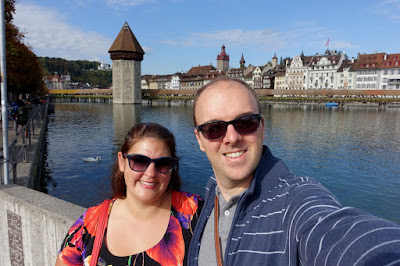So forget about the Kapellbrücke from last time. Now we get to my favourite bridge, the Spreuer Bridge. Apart from not being mostly burnt down (sob), the Spreuer shines for its cool 17th century images of the
Danse macabre (Totentanz in German) and its lovely sight lines. We visited it first by day, and luckily enough, walked past it by chance at night as well. I definitely recommend a night visit. It looks great lit up in the darkness and you may have the bridge virtually to yourself.
The Spreuer bridge is younger than the Kapellbrücke, but not by much. It was originally built in the 13th century, but rebuilt in the 16th after a flood. I thought
memento mori was pretty much a medieval thing, but apparently it was still going strong in Switzerland into the 17th century.
A 19th-century book on the bridge (my source for translations all of the painting captions below) explains that they originally planned "scenes with a merry meaning" but changed course after "the country was visited soon afterwards by heavy calamities, as war and pestilence". Just when you think you would need cheering up! 45 of the paintings still exist out of the original 67, making it the largest known
Totentanz cycle in existence. I think I took photos of all of them!
 |
| Jules standing under the first picture of the cycle "Dance at the cemetary" |
 |
| Arches leading to the bridge |
 |
| The Resurrection of Death: "Upon Ezekiel did light break/And he unto the truth did wake/How by the Spirit of God, dead men,/With living flesh, are clothed again" |
 |
| The Dying Woman: "Death contemplated oft have I,/By day and night, my life long nigh;/No heed I give him in this hour,/Yet cometh he in all his power" |
 |
| The Child: "So soon a child is born, its cry/Is woe, its first plaint too a sigh./Its message thus the world does send,/That every hour a life should end." |
 |
| The Bishop: "A consecrated Bishop, I,/Yet Death cannot elude thereby./He taketh mitre, breaketh stave,/And casteth me in the cold grave" |
 |
| The Duke: "Of princely blood, a Duke serene,/With courage high, and of haughty mien,/Still bold and young, of joyous grace,/Death taketh me in his embrace." |
 |
| The Gardener: "If kindly Nature help not art,/Planting be useless, leave thy part./For how wilt to the flowers restore/That life, which I from thee take o'er?" |
 |
| The Duchess: "A woman fair, my tender frame/I keep, till cruel Death the same/From me doth drive, just as the blast/The beauteous rose to Earth doth cast" |
 |
| The Soldier: "Courage, good soldier! Parry well./Have care no wound my weapon fell/Imbued with serpent venom make./Must die if struck. Thy life I take." |
 |
| The Countess: "Hold Coachman! Spare me yet I pray,/Am not prepared, go not today./My lady Countess, Death am I,/Say me no word, away I hie." |
 |
| The Dying Monk: "Beloved brethren, hasten all/The De Profundis doth ye call,/Death's anguish doth oppress me sore,/My cowl and sleeves are wide no more." |
 |
| The Prioress: "Lady Prioress, thy life is o'er./Of Heaven is open wide the door./Draw off thy spotless veil, prepare/With me the moudly grave to share." |
 |
| The Abbess: "Jesu Maria! What neareth me?/Death I did not expect to see./Must it come now, my final doom,/To Jesus I go, my bridegroom." |
 |
| The Queen: "Where is my King, my kingdom court?/Who fighteth for me, aideth ought?/As Death doth strike, my heart doth bleed./Each turneth from me in my need." |
 |
| The Abbot: "Once of the Convent I was Prior;/Now Abbot, Primate, rise I higher./Go age and honour hand in hand,/Doth ebb the last dread hour's sand." |












































